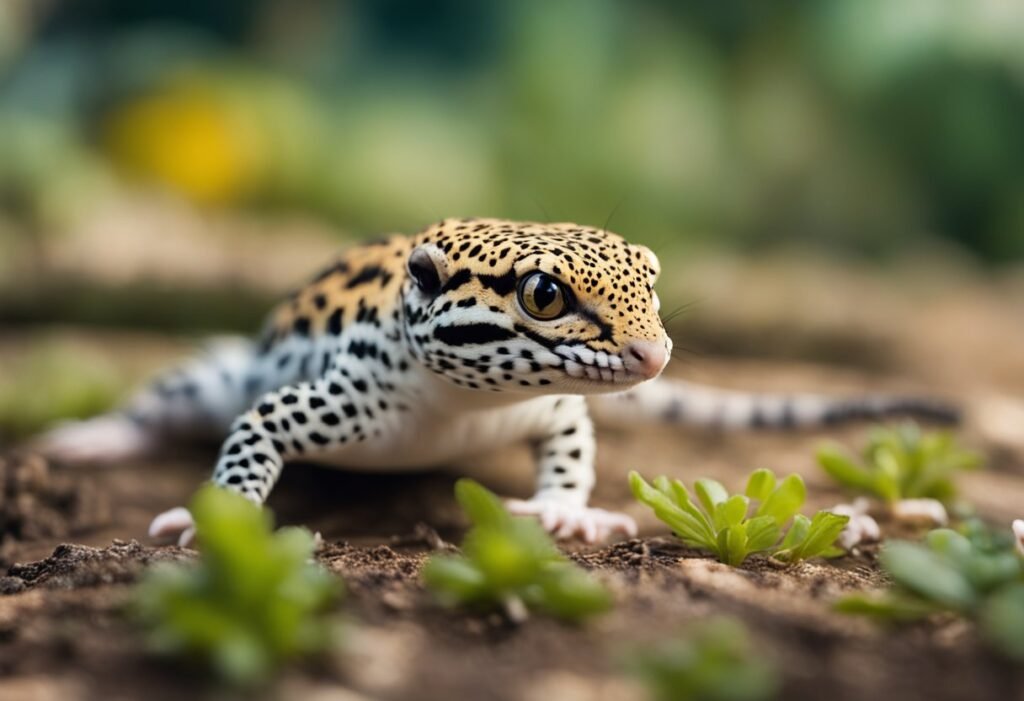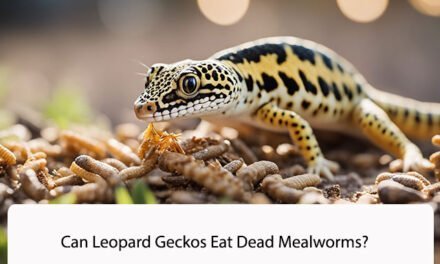Leopard geckos are popular pets that are known for their unique appearance and docile nature. As with any pet, it’s important to provide them with a balanced and nutritious diet. One question that often arises is whether or not leopard geckos can eat baby mice.
The short answer is yes, leopard geckos can eat baby mice. In fact, they are carnivores and require a diet that is high in protein. However, it’s important to note that feeding live prey to your leopard gecko can come with some risks. Baby mice can bite and injure your gecko, and they may also carry diseases. As such, it’s recommended to feed your gecko pre-killed or frozen-thawed prey.
When it comes to feeding your leopard gecko, it’s important to do your research and provide them with a diet that meets their nutritional needs. While baby mice can be a part of their diet, it’s important to take precautions to ensure the safety of your pet. By providing your gecko with a balanced and varied diet, you can help them to live a healthy and happy life.
Dietary Basics of Leopard Geckos

Leopard geckos are insectivorous reptiles that require a balanced diet to maintain good health. In the wild, they primarily feed on insects, but in captivity, they can be fed a variety of prey items, including baby mice. In this section, we will discuss the nutritional needs of leopard geckos and their common prey choices.
Nutritional Needs
Leopard geckos require a diet that is high in protein and low in fat. They also need a variety of vitamins and minerals to maintain good health. Calcium and vitamin D3 are particularly important for proper bone growth and development.
When feeding leopard geckos, it is important to provide them with a balanced diet that includes a variety of prey items. Feeding them only one type of prey can lead to nutritional deficiencies and health problems.
Common Prey Choices
Leopard geckos can be fed a variety of prey items, including crickets, mealworms, superworms, and baby mice. Crickets are a popular choice because they are readily available and easy to digest. Mealworms and superworms are also good choices, but they should be fed in moderation because they are high in fat.
Baby mice can be fed to leopard geckos, but they should be used sparingly and only as a treat. Feeding too many baby mice can lead to obesity and other health problems. It is important to note that feeding live prey to leopard geckos can be dangerous, as the prey can injure the gecko. It is recommended to feed pre-killed prey or to supervise feeding sessions closely.
In conclusion, leopard geckos require a balanced diet that includes a variety of prey items. Feeding them baby mice is acceptable as long as it is done in moderation and as a treat. It is important to provide them with a diet that is high in protein and low in fat, and to ensure that they receive the necessary vitamins and minerals for good health.
Feeding Practices for Leopard Geckos
Leopard geckos are insectivores, meaning they primarily eat insects. However, they can also eat small vertebrates such as baby mice. In this section, we will discuss the feeding practices for leopard geckos.
Feeding Frequency
Leopard geckos should be fed every day or every other day. It is important not to overfeed them as this can lead to obesity and health problems. The amount of food given should be proportional to the gecko’s size. Adult geckos should be fed 3-4 insects per feeding, while juveniles should be fed 2-3 insects per feeding.
Prey Size Considerations
When feeding leopard geckos, it is important to consider the size of the prey. The size of the prey should be no larger than the width of the gecko’s head. This is to prevent the gecko from choking or having difficulty digesting the food. It is also important to provide a variety of prey items to ensure a balanced diet.
Leopard geckos can eat baby mice, but this should only be done occasionally as it is not a natural part of their diet. It is important to ensure that the mouse is appropriately sized for the gecko and that it is fed in moderation.
In conclusion, leopard geckos should be fed a balanced diet of insects and occasional small vertebrates such as baby mice. Feeding frequency and prey size should be carefully considered to ensure the gecko’s health and well-being.
Safety Considerations

Risk of Impaction
When feeding leopard geckos baby mice, it is important to consider the risk of impaction. Leopard geckos are known to swallow their prey whole, and if the prey is too large or not properly prepared, it can become lodged in their digestive tract and cause serious health problems.
To prevent impaction, we recommend feeding appropriately sized prey. The size of the prey should be no larger than the width of the gecko’s head. Additionally, it is important to ensure that the prey is properly thawed and warmed to room temperature before feeding.
Appropriate Prey Handling
When handling baby mice for feeding, it is important to take appropriate precautions to prevent the spread of disease. We recommend using disposable gloves when handling prey and washing your hands thoroughly before and after handling.
It is also important to purchase prey from a reputable source to ensure that it is free from parasites and disease. If you are breeding your own prey, be sure to follow proper hygiene practices and regularly clean and disinfect the breeding enclosure.
In conclusion, while feeding baby mice to leopard geckos can be a nutritious and appropriate part of their diet, it is important to take appropriate safety considerations to prevent health problems. By feeding appropriately sized prey and taking proper precautions when handling, you can ensure the health and wellbeing of your gecko.
Alternatives to Baby Mice
If you’re looking for alternative feeding options for your leopard gecko, there are a few options to consider. In this section, we’ll cover two main alternatives: insect options and commercial diets.
Insect Options
Leopard geckos are insectivores, so feeding them insects is a great way to provide them with the nutrients they need. Here are some insect options to consider:
- Crickets: Crickets are a popular choice for feeding leopard geckos. They are high in protein and easy to find at most pet stores.
- Mealworms: Mealworms are another common option. They are high in fat, so they should be fed sparingly.
- Dubia Roaches: Dubia roaches are a great option for leopard geckos. They are high in protein and low in fat, making them a healthy choice.
Commercial Diets
If you’re not comfortable feeding your leopard gecko live insects, there are also commercial diets available. Here are some options to consider:
- Repashy Superfoods: Repashy Superfoods is a powdered food that can be mixed with water to create a gel. It contains all the nutrients that leopard geckos need.
- Pangea Fruit Mix: Pangea Fruit Mix is a powdered food that can be mixed with water to create a paste. It contains fruit and insects, making it a healthy option for leopard geckos.
- Zoo Med Can O’ Crickets: Zoo Med Can O’ Crickets is a canned food that contains cooked crickets. It’s a convenient option for those who don’t want to deal with live insects.
Overall, there are many options available for feeding your leopard gecko. It’s important to choose a diet that meets their nutritional needs and is appropriate for their age and size.
Understanding Leopard Gecko Behavior

Leopard geckos are fascinating creatures with unique behaviors that are important to understand in order to provide them with proper care. In this section, we will discuss two important aspects of leopard gecko behavior: hunting instincts and feeding responses.
Hunting Instincts
Leopard geckos are natural hunters and have a strong instinct to chase and capture prey. They are nocturnal animals and use their keen sense of smell and vision to locate their prey in the dark. When hunting, they will stalk their prey and then pounce on it with lightning-fast reflexes.
In captivity, it is important to provide leopard geckos with opportunities to express their hunting instincts. This can be done by offering live prey, such as crickets or mealworms, which will stimulate their natural hunting behavior. It is important to supervise feeding to ensure that the prey is not too large and that the gecko is able to capture and consume it safely.
Feeding Responses
Leopard geckos have unique feeding responses that are important to understand in order to ensure that they are eating properly. When presented with food, they will often lick their lips and show interest by moving towards it. They may also wave their tail or wiggle their body in excitement.
It is important to offer a varied diet to leopard geckos to ensure that they are receiving all of the necessary nutrients. In addition to live prey, they can also be fed commercial diets specifically formulated for leopard geckos. It is important to monitor their weight and adjust their diet accordingly to ensure that they are maintaining a healthy body condition.
Overall, understanding leopard gecko behavior is essential for providing them with proper care and ensuring their health and wellbeing. By providing opportunities for them to express their natural hunting instincts and offering a varied diet, we can help these fascinating creatures thrive in captivity.
Frequently Asked Questions
Is it safe for leopard geckos to consume pinky mice?
Yes, it is safe for leopard geckos to consume pinky mice. In fact, pinky mice are a good source of nutrition for leopard geckos.
What are the dietary implications of feeding pinky mice to leopard geckos?
Pinky mice are a good source of protein and fat for leopard geckos. They can help supplement their diet and provide additional nutrients that may be lacking in their regular diet.
How often can leopard geckos be fed pinky mice?
Leopard geckos can be fed pinky mice once every two weeks. It is important to not overfeed them, as this can lead to health problems.
What size of pinky mice is appropriate for leopard geckos?
Leopard geckos should be fed pinky mice that are no larger than the width of their head. This ensures that they can properly digest the food and avoid any health issues.
Are there any health risks associated with leopard geckos eating pinky mice?
There are no major health risks associated with leopard geckos eating pinky mice. However, it is important to ensure that the pinky mice are properly sourced and free from any diseases.
Can leopard geckos digest pinky mice properly?
Leopard geckos have a strong digestive system and are able to digest pinky mice properly. However, it is important to ensure that the pinky mice are not too large and are properly prepared before feeding.





